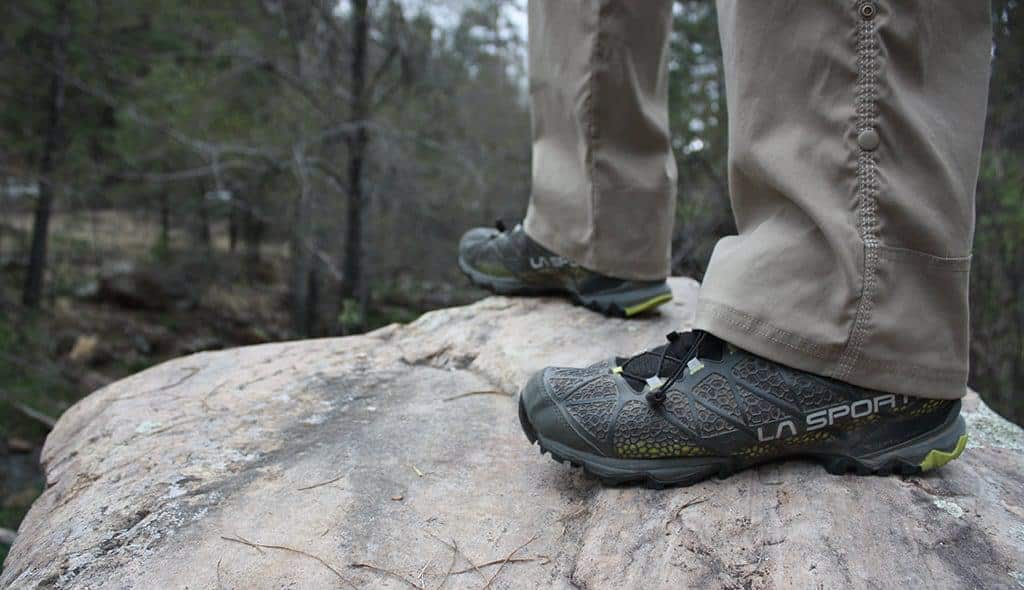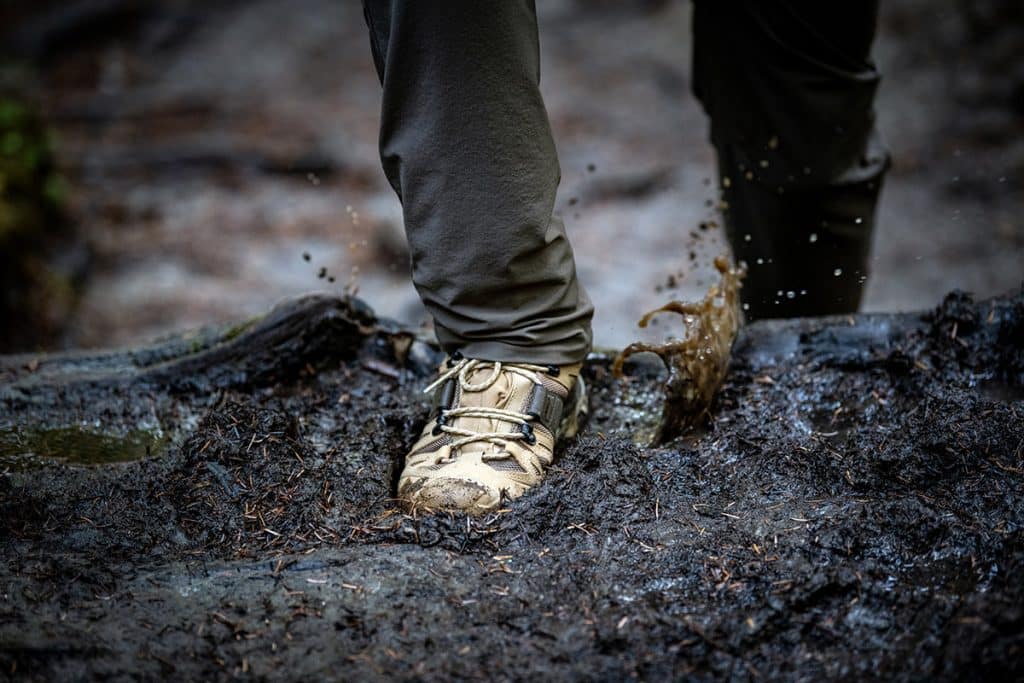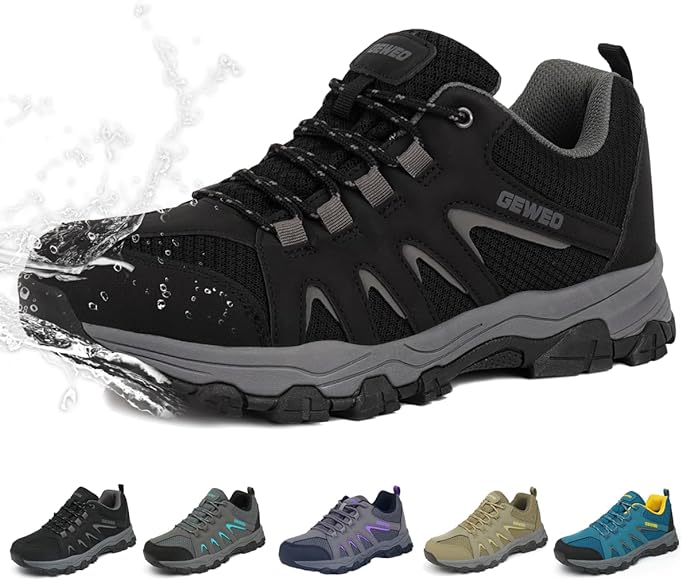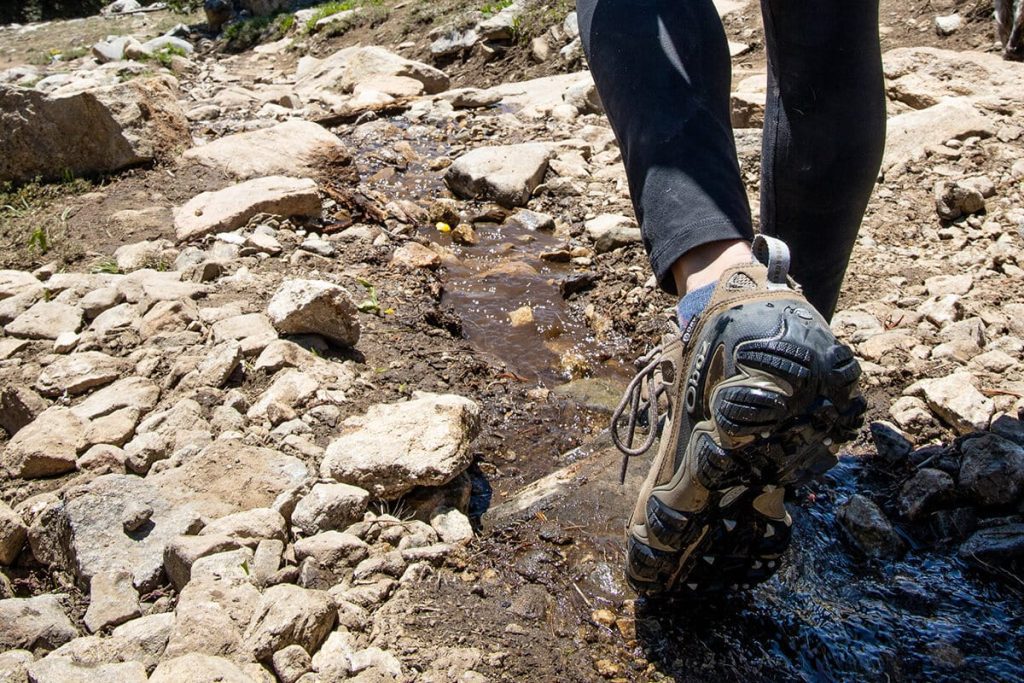If you’ve ever embarked on a hiking adventure, chances are you’ve grappled with the eternal footwear dilemma: do waterproof hiking shoes sacrifice breathability?
As avid explorers, we understand the importance of keeping our feet dry while maintaining optimal comfort and flexibility. In this article, we explore the intricate relationship between waterproofing and breathability in hiking shoes, debunking myths and shedding light on the key features to look for in your next pair of trail-ready kicks.
Discover the truth behind the age-old question: are waterproof hiking shoes breathable?
1. What are waterproof hiking shoes?
Waterproof hiking shoes are footwear specifically designed for hiking and outdoor activities in wet conditions. As the name suggests, these shoes are designed to keep the wearer’s feet dry by preventing water from entering the shoe. They use unique materials and construction techniques that create a barrier against water penetration, ensuring that hikers can confidently trek through wet terrain without worrying about their feet getting wet.
2. How do waterproof hiking shoes work?
2.1. The materials used in waterproof hiking shoes
Waterproof hiking shoes are made using a combination of materials that work together to prevent water from entering the shoe. The most common material used for waterproofing is a membrane, such as Gore-Tex or eVent, which is sandwiched between the outer and inner layers of the shoe. This membrane has microscopic pores that allow moisture vapor, such as sweat, to escape while blocking water droplets from entering.
In addition to the membrane, the outer layer of the shoe is often treated with a durable water-repellent (DWR) coating. This coating helps shed water and prevents it from saturating the shoe’s outer layer. The waterproof membrane and DWR coating combination ensures that water cannot penetrate the shoe, keeping the wearer’s feet dry.
2.2. The construction of waterproof hiking shoes
Apart from the materials used, the construction of waterproof hiking shoes also plays a crucial role in how effectively they keep water out. These shoes often feature sealed seams or waterproof stitching to prevent water from seeping through the tiny gaps between different shoe parts. Additionally, they may have gussets or bellows tongues that further enhance the waterproofing by blocking water from entering through the shoe’s opening.
The shoe’s design also plays a role in its overall water resistance. Many waterproof hiking shoes have a higher cut or ankle collar that protects against water entering the shoe from above. The lacing system is often designed to create a snug fit and prevent water from entering through the gaps between the shoe and the wearer’s foot.
This image is the property of www.switchbacktravel.com.
3. The importance of breathability in hiking shoes
3.1. Why breathability matters for hikers
While waterproofing is essential for keeping the feet dry, breathability is equally important for maintaining comfort on the trail. When we hike, our feet naturally sweat as they work hard to keep us moving. If this moisture cannot escape, it can build heat and moisture inside the shoe, causing discomfort and potentially leading to blisters, hot spots, or fungal infections like athlete’s foot.
Breathable hiking shoes allow the moisture vapor created by our feet to escape, helping to regulate the temperature and maintain a comfortable environment inside the shoe. This is especially crucial during long hikes or warmer weather when our feet are more prone to sweating. By allowing air circulation and moisture evaporation, breathable shoes help to keep the feet dry, calm, and comfortable throughout the hike.
3.2. The effects of non-breathable shoes on hikers
Wearing non-breathable shoes on a hike can hurt comfort and performance. The feet become hot and sweaty without releasing moisture vapor, creating a damp environment inside the shoe. This can lead to discomfort, blisters, and even foot odor. The moisture accumulation can also soften the skin, making it more susceptible to rubbing and abrasions, increasing the risk of blisters and hot spots.
Moreover, excessive moisture inside non-breathable shoes can compromise the overall health of our feet. Prolonged exposure to a moist environment increases the likelihood of fungal or bacterial infections, which can be challenging to treat and may require medical attention. Therefore, choosing breathable hiking shoes is vital for comfort and the overall health and well-being of our feet during outdoor activities.
4. Can waterproof hiking shoes be breathable?
The traditional perception has often been that waterproof and breathable qualities in hiking shoes are mutually exclusive. Many hikers have faced a dilemma when choosing between shoes that are either waterproof or breathable, struggling to find a perfect balance. However, advancements in technology and the development of innovative materials have led to the emergence of waterproof hiking shoes that offer a certain degree of breathability.
While it is true that the waterproof membrane in these shoes can restrict airflow to some extent, manufacturers have made significant progress in improving breathability without compromising the waterproofing capabilities. High-quality waterproof hiking shoes now incorporate breathable membranes that allow moisture vapor to escape while effectively repelling water from entering the shoe. This enables hikers to enjoy the benefits of both waterproofing and breathability in a single shoe.
This image is the property of www.gore-tex.com.
5. Differentiating between waterproof and breathable hiking shoes
It is essential to understand the distinction between waterproof and breathable hiking shoes. While waterproof shoes are designed to keep water out, breathable shoes are focused on allowing airflow and moisture evacuation. Waterproof hiking shoes prioritize keeping the feet dry, even in wet conditions. In contrast, breathable hiking shoes prioritize keeping the feet cool and comfortable by releasing moisture vapor.
One key differentiator is the presence of a waterproof membrane in waterproof hiking shoes. This membrane acts as a barrier against water penetration, ensuring the shoe remains dry even when submerged. Breathable hiking shoes, however, may not include a waterproof membrane but instead, focus on maximizing airflow and moisture management.
When choosing between the two, one must consider the specific hiking conditions and personal preferences. If hiking in wet or rainy environments is the primary concern, waterproof hiking shoes may be preferred. On the other hand, breathable hiking shoes can provide a comfortable experience in various hiking conditions if breathability and moisture management are more critical.
6. Factors affecting breathability in hiking shoes
To understand the breathability of hiking shoes and make an informed choice, it is essential to consider various factors that affect the shoe’s ability to release moisture vapor effectively. These factors include design and construction features, materials used in the shoe’s upper, lining and membrane, insulation and weather protection features, and the fit and ventilation systems incorporated into the shoe.
6.1. Design and construction features
The design and construction of hiking shoes can significantly impact their breathability. Shoes with mesh panels or a more open design allow for better air circulation and ventilation, promoting the release of moisture vapor. Shoes with strategically placed perforations or breathable zones also enhance breathability by allowing air to flow through the shoe, carrying away excess heat and moisture.
Additionally, some hiking shoes feature drainage systems that facilitate the removal of water from the shoe in case moisture does enter through the openings or during water crossings. These drainage systems contribute to overall breathability by preventing the build-up of excess moisture inside the shoe.
6.2. Materials used in the shoe’s upper
The choice of materials in the upper part of the shoe can influence breathability. Synthetic materials, such as mesh or perforated fabrics, are commonly used in breathable hiking shoes to promote airflow and escape moisture vapor. These materials are lightweight, quick-drying, and provide good ventilation, ensuring the feet stay cool and dry during hikes.
Natural materials like leather or suede, while durable and water-resistant to some extent, tend to be less breathable than their synthetic counterparts. When choosing a leather hiking shoe, it is essential to consider the presence of breathable features, such as mesh inserts or perforations, to mitigate the potential lack of breathability inherent in natural materials.
6.3. The shoe’s lining and membrane
The choice of lining and membrane in waterproof hiking shoes also affects breathability. Fabrics with moisture-wicking properties, such as mesh or synthetic linings, can help to actively draw moisture away from the feet, promoting evaporation and enhancing breathability. Additionally, the membrane used for waterproofing in the shoe should ideally have breathable properties, allowing moisture vapor to escape while still repelling water.
Breathable membranes like Gore-Tex or eVent are commonly used in high-quality waterproof hiking shoes. These membranes have microscopic pores that are small enough to prevent water droplets from entering the shoe but large enough to allow moisture vapor to escape. This balance between waterproofing and breathability is crucial to maintaining a comfortable and dry environment inside the shoe.
6.4. Insulation and weather protection features
In colder or wetter conditions, insulation and weather protection features may be necessary in hiking shoes. However, these features can sometimes compromise breathability. Insulated hiking shoes, for example, tend to be less breathable due to the additional layers of insulation that trap heat and restrict airflow. While this may suit winter hikes, it may not be ideal for warmer weather when breathability is paramount.
If insulation is required, selecting shoes with removable liners or adjustable ventilation options can provide versatility in various weather conditions. This allows hikers to adapt their footwear to different temperature ranges and manage breathability accordingly.
6.5. Fit and ventilation systems
The fit and ventilation systems incorporated into the shoe can significantly impact breathability. Shoes that provide a comfortable and secure fit, with enough room for toe movement, promote air circulation and reduce the likelihood of friction and sweating. Snug, well-fitting shoes with proper arch support and cushioning also prevent excessive foot movement, reducing the risk of blisters and discomfort.
Ventilation systems, such as breathable insoles or perforated footbeds, enhance breathability by allowing air to circulate within the shoe. Some hiking shoes also feature ventilation channels or ports that release heat and moisture, ensuring optimal airflow and breathability.
This image is the property of www.switchbacktravel.com.
7. The trade-off between waterproofness and breathability
While waterproof and breathable hiking shoes do exist, it is essential to recognize that there is a trade-off between waterproofness and breathability. The more waterproof a shoe is, the less breathable it may be, and vice versa. Achieving a perfect balance between the two qualities is challenging, and hikers often need to prioritize one aspect over the other based on their specific needs and hiking conditions.
7.1. Achieving a balance
When selecting waterproof hiking shoes, one must evaluate personal preferences and the anticipated hiking conditions. If hiking in wet or rainy environments is frequent, it may be necessary to prioritize waterproofing over breathability to ensure that feet remain dry and protected. On the other hand, prioritizing breathability can enhance overall comfort if hiking in warmer weather or engaging in activities that induce more sweating.
Some hiking shoe manufacturers offer models incorporating technologies specifically to strike a balance between waterproofness and breathability, combining the best of both worlds. These shoes often employ advanced membrane systems, optimized ventilation features, and innovative materials to provide effective waterproofing while minimizing the compromise on breathability.
7.2. Understanding the limitations
It is essential to understand that no hiking shoe can simultaneously be 100% waterproof and 100% breathable. The inherent qualities necessary for waterproofing, such as a waterproof membrane and tightly sealed seams, can restrict the airflow and limit breathability to some extent. Similarly, shoes prioritizing breathability may not provide complete protection against water penetration.
Therefore, managing expectations and focusing on finding a shoe that offers a suitable balance for specific hiking needs is crucial. By understanding the limitations and considering factors such as anticipated weather conditions, trail difficulty, and personal comfort preferences, hikers can make an informed decision and choose a hiking shoe that meets their unique requirements.
8. Test methods and standards for assessing breathability
8.1. The importance of standardized testing
Measuring the breathability of hiking shoes and ensuring consistency across different brands and models requires standardized testing methods. These tests help manufacturers, retailers, and consumers understand the breathability performance of a shoe and make informed comparisons between different options.
Standardized testing provides objective and quantifiable data that can be used to assess the breathability of a hiking shoe. By adhering to established testing methods, manufacturers can provide accurate information about a shoe’s breathability capabilities, enabling hikers to make informed purchase decisions based on empirical data rather than just marketing claims.
8.2. Common methods used to measure breathability in hiking shoes
Several standard methods are used to measure the breathability of hiking shoes. One widely recognized method involves assessing the shoe’s ability to transport moisture vapor through the fabric using a sweating-guarded hotplate. This method simulates the heat and moisture generated by the foot during hiking, allowing for an accurate evaluation of the shoe’s performance in releasing moisture.
Another commonly used test involves the measurement of the shoe’s permeability to air. This test evaluates the shoe’s ability to allow air to flow through the material, indicating its overall breathability. The Shoe Permeability Index (SPI) is often used to classify footwear based on its permeability levels, providing an easy-to-understand reference for consumers.
By employing these testing methods, manufacturers can ensure the breathability of their hiking shoes and provide reliable information to consumers. Hikers need to look for shoes that have undergone standardized testing to make informed decisions about the footwear’s breathability.
This image is the property of Amazon.com.
9. Tips for choosing breathable waterproof hiking shoes
When selecting breathable waterproof hiking shoes, it is essential to consider various factors to find the best fit for your needs and hiking preferences. Here are some tips to help you make an informed choice:
9.1. Researching and reading product details
Before making a purchase, thoroughly researching different brands and models of hiking shoes is always a good idea. Read product descriptions, specifications, and customer reviews to gather information about the breathability and waterproofing capabilities of the shoes you are considering. Look for shoes that explicitly highlight their breathability features and mention the use of breathable materials and technologies.
9.2. Trying on and testing the shoes
Visiting a brick-and-mortar store and trying on different pairs of hiking shoes allows you to assess the fit and comfort of the shoes. Pay attention to the breathability features during the fitting process. Look for shoes with mesh panels, perforations, or other ventilation systems promoting breathability.
If trying the shoe in-store is impossible, consider ordering multiple sizes or styles online and returning the ones that do not meet your expectations. This way, you can test the shoes in real-life hiking conditions to see how they perform in breathability.
9.3. Considering personal preferences and hiking conditions
Think about the specific hiking conditions you are likely to encounter. If you primarily hike in wet or rainy environments, waterproofing may be your top priority.
However, breathability becomes crucial if you hike in warmer weather or engage in activities that induce more sweating. Consider your comfort preferences and make an informed decision based on your needs.
9.4. Seeking expert advice or recommendations
If you are unsure about which breathable waterproof hiking shoes to choose, seeking advice from outdoor gear experts, experienced hikers, or reputable retailers can be beneficial.
They can provide valuable insights and recommendations based on their knowledge and firsthand experience with different hiking shoe models. Exploring online forums, discussing with fellow hikers, or reaching out to customer support can also help gain a better understanding and make an informed decision.
10. Maintaining the breathability of waterproof hiking shoes
To ensure that your breathable waterproof hiking shoes continue to perform optimally, it is essential to follow proper cleaning and care techniques:
10.1. Proper cleaning and care techniques
Regularly cleaning your hiking shoes helps remove dirt, mud, and debris affecting breathability. Follow the manufacturer’s instructions for cleaning, which typically involve using a mild detergent, warm water, and a brush.
Avoid using harsh cleaners or abrasive tools that damage the shoes’ materials and compromise their breathability.
After cleaning, allow your hiking shoes to air dry naturally, away from direct heat sources. This prevents shrinkage or deformation of the materials and ensures that the shoes maintain their breathability properties.
10.2. Restoring water repellency and breathability
Over time, the DWR coating on your hiking shoes may wear off, reducing the water repellency. To restore the DWR coating, consider using a specialty waterproofing product compatible with your shoe’s materials. Follow the manufacturer’s instructions for application, ensuring that the product is evenly distributed and covers all areas of the shoe.
Additionally, if you notice a decrease in breathability or an accumulation of moisture inside the shoe, cleaning the shoe’s membrane may be necessary. This can be done by rinsing the shoe with warm water and a mild detergent, following the manufacturer’s instructions. Proper maintenance and restoration of the shoe’s water repellency and breathability will ensure that your footwear continues to provide optimal performance on the trail.
In conclusion, waterproof hiking shoes can be breathable, thanks to technological advancements and innovative materials. Manufacturers have developed shoes that balance waterproofing and breathability, allowing hikers to enjoy the benefits of both qualities.
Understanding the construction, materials, and design features contributing to breathability in hiking shoes is crucial in making an informed choice. By considering personal preferences and hiking conditions and conducting thorough research, hikers can select breathable waterproof hiking shoes that provide the necessary protection and comfort for their outdoor adventures.
Regular maintenance and care will ensure that the shoes perform optimally and maintain their breathability over time. So, lace up your breathable, waterproof hiking shoes and embark on your next adventure with dry and comfortable feet!
This image is the property of bearfoottheory.com.













































